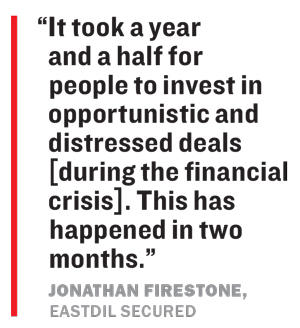Trending
Not your father’s distress: Down market could be opportunity of a lifetime or a big letdown
Contrarian investors have billions in dry powder, but government relief efforts and a crowd of buzzards could complicate things

As the coronavirus pandemic bore down on the economy, veteran investor Tom Barrack emerged as one of the loudest voices urging a lifeline for the real estate industry.
Barrack, the head of Colony Capital and a longtime friend of President Donald Trump, penned a series of much-discussed blog posts and took to the airwaves, warning that the real estate industry could collapse. His alarm hit close to home when Colony disclosed this month that it had defaulted on $3.2 billion worth of loans backing the company’s hotel and health care properties.
The bad news for Colony presented an opportunity for real estate investors who have been waiting since the last global crisis to snap up distressed real estate at bargain prices. But while many based their playbooks on the Great Recession, the pandemic’s playing field looks quite different.
One of the biggest differences is that the current crisis hasn’t resulted in a breakdown of the banking system — at least not yet. Some lenders may be skittish and hesitant to make loans, but the global and U.S. financial industries are, by and large, still working. Although that could change if massive defaults lead to a banking crisis.
And this time around, investors are game planning and looking at opportunities a lot earlier, said Eastdil Secured managing director Jonathan Firestone.
When the housing and financial markets collapsed in 2008, “people were afraid of their own shadows,” Firestone noted. “It took a year and a half for people to invest in opportunistic and distressed deals. This has happened in two months.”
Investors who reaped big returns following the financial crisis — and those who regret missing out — are now salivating. Some have been ready for more than a decade for such an opportunity to unleash capital. As of mid-May , distressed real estate funds have already accumulated nearly $10 billion worth of dry powder, according to private equity data firm Preqin. Nine others were raising distressed funds with an aggregate goal of $7.3 billion.
Those include Oaktree Capital Management, led by billionaire contrarian investor Howard Marks. Oaktree is raising a $15 billion general distressed-debt fund, and a separate $3.5 billion fund designated for underwater real estate assets. “The firewood had been stacked,” Marks said in a recent presentation to investors.
Brookfield Asset Management paid $4.8 billion last year to buy a 61 percent stake in Oaktree in a bid to challenge Blackstone Group, which is also gearing up. Another rival, Cerberus Capital Management, is raising a $2 billion distressed fund. And other giants, including JPMorgan Chase and Fortress Investment Group, are raising billions of dollars for general distressed funds targeting different sectors of the economy.
 Daniel Lebensohn, head of investment firm BH3, told the Wall Street Journal that companies like his see this as a rare moment to invest. “There are people that do have dry powder, like us, and that will recognize this as one of the greatest buying opportunities of the century,” said Lebensohn, whose company raised a $100 million distressed-debt fund in late 2018.
Daniel Lebensohn, head of investment firm BH3, told the Wall Street Journal that companies like his see this as a rare moment to invest. “There are people that do have dry powder, like us, and that will recognize this as one of the greatest buying opportunities of the century,” said Lebensohn, whose company raised a $100 million distressed-debt fund in late 2018.
But despite the ambitions of big gains, the vultures are so far waiting to see how things shake out. Government intervention and relief efforts have disrupted some distress plans already. And since the public health crisis has not spiraled into a financial one — though it very well might — investors have yet to see the rush of opportunities they did a decade ago.
“Back in ’08 you could spit in any direction and you had a problem,” said David Eyzenberg, president of the investment banking firm, Eyzenberg & Company. “Right now you don’t really have any distressed sellers. What you have is short-term impairment in cash flow.”
“The playbook is slightly harder today,” Eyzenberg added.
The asset food chain
Earlier this month, the Hilton Times Square Hotel’s $92 million securitized loan went into special servicing as the building’s landlord, Sunstone Hotel Investors, failed to meet debt payments.
The Hilton was one of a handful of hotels in the city in a precarious situation even before the coronavirus hit, as revenues were short and owners were already struggling to cover their mortgages.
Properties like those are the first to fall into distress, industry sources say.
“What we’re really focusing on are loans that were teetering before Covid, and then Covid put them under,” Iron Hound Management’s Robert Verrone, one of the industry’s most seasoned loan workout experts, told The Real Deal in an April video interview.
Asked about nonperforming debt notes, Verrone said, “You are going to see a lot of distressed everything.”
Hotels have been among the hardest-hit asset classes as the pandemic brought business conferences, tourism and travel to a virtual halt. The national occupancy rate bottomed out at about 25 percent in late April, according to the hospitality data firm STR. Had many of the emptiest hotels not closed, removing their vacant rooms from the calculation, the rate would have been far lower.
But the U.S. hotel industry saw an uptick in early May as travelers went to resort towns in states like Florida and Texas that began lifting restrictions. The bounceback gave hope to those in the sector that hotels could quickly recover when more states reopen.
“Whether or not this becomes a trend remains to be seen,” said Jan Freitag, senior vice president of lodging insights at STR. “But the fact that there were people instantly willing to head out for leisure activity and stay in hotels is a positive sign for the industry.”
 The retail market is also in trouble as a domino effect of store chains failing to pay rent puts mall owners and other landlords on the defensive.
The retail market is also in trouble as a domino effect of store chains failing to pay rent puts mall owners and other landlords on the defensive.
National retail chains paid just 58 percent of their rent in April, according to data firm Datex Property Solutions. That was down from 96 percent during the same period last year. H&M, Gap, Foot Locker, Barnes & Noble and two dozen others among the 135 chains in Datex’s report paid little or no rent at all.
During the first quarter, mall giant Macerich reported it collected just 26 percent of rent from tenants at 47 shopping centers it owns around the country.
At the same time, a growing number of popular brands, including J. Crew and Neiman Marcus, have filed for bankruptcy in the past two months. Given the runup in retail rents in the years following the last crisis, coupled with the detrimental impacts of e-commerce, retail is seen by many as one of the biggest opportunities to snap up bargain deals.
“The whole transition from bricks and mortar to online shopping got sped up by 10 years in the last few weeks,” said Danny Wrublin, of Dalan Management, who last year launched a $500 million distressed debt fund with HKS Capital Partners and Bain Capital.
Wrublin added that given the uncertainty over how long it will take certain retailers — especially restaurants and entertainment venues — to return to normal in the age of social distancing, the timeline for fixing distressed retail properties will be longer than last time.
“It’s going to be a question of having staying power,” he said. “In the immediacy of what’s happened, there’s going to be a lot less demand.”
In a potential lifeline and perhaps contrary move to its Oaktree investment, Brookfield Asset Management is reportedly planning to spend $5 billion to prop up struggling retailers.
On the multifamily side, there’s been much hand-wringing over whether tenants would be able to pay rent. By early May, roughly 80 percent of 11.4 million U.S. households surveyed by the National Multifamily Housing Council said they paid all or part of their rent. The survey, it should be noted, is heavily weighted toward large institutional property owners.
At the same time, institutions insured by the FDIC had $458.7 billion in outstanding multifamily loans at the end of 2019, the agency’s data show. And as U.S. unemployment surges higher — with jobless claims hitting 36 million since the beginning of the pandemic — renters increasingly lack the resources to compensate for major income losses, according to Harvard University’s Joint Center for Housing Studies.
Peter Von der Ahe, who leads the New York multifamily team at the brokerage Marcus & Millichap, told TRD in April that opportunistic investors are lining up “with the stands full, saying, ‘I have cash ready to go.’”
Deals won’t start getting done, he added, until sellers and buyers find more common ground on how much properties are worth now.
“The problem is, do they agree on pricing?” he noted.
No “forbearance fairy”
As more commercial and residential tenants begin to skip out on rent checks, a growing number of property owners are turning to their lenders for relief. But that can only go so far for some borrowers and it can be an arduous process.
About 26 percent of borrowers with CMBS loans have asked their special servicers about relief since the coronavirus started, according to Fitch Ratings. Of those requests, just 3 percent have been transferred to special servicing. The number of calls for help dipped in late April, but that’s expected to be just a lull before more borrowers seek a break.
“This is not a positive indicator, but likely the calm before the storm as higher delinquencies and more relief requests come in May,” said Fitch U.S. CMBS senior director Adam Fox.
Ironhound’s Verrone said many borrowers have to be educated about what kind of relief they can expect when negotiating with their lenders. “[Some] feel like there’s some forbearance fairy flying around that’s just sprinkling dust on loans that are Covid-affected,” he said. “I know that’s not the case.”
Investors are lining up to buy stressed or nonperforming loans, hoping they can turn a profit by reworking the loans or, in some cases, taking control of the properties. But if opportunities don’t arise the way they imagine, those funds risk posting underperforming returns.
That will take more time to shake out. Meridian Investment Sales’ David Schechtman said it will be several months before distress activity really starts to heat up.
“The loan sales market at the moment feels a lot like being at Disney World without a fast pass,” he said. “Everyone is queued up and ready to go, but the sign says it’s another six months from this point on line to ride Space Mountain.”
Federal obstacles
There’s also a question about how deep the hit on real estate will — or should — be.
The federal government’s $6 trillion intervention thus far will soften the blow. That figure includes the $2.15 trillion Coronavirus Aid, Relief, and Economic Security (CARES) Act and trillions the Federal Reserve has spent to prop up financial markets by buying bonds and mortgage-backed securities.
Some are now asking for industry-specific bailouts for troubled sectors, such as hospitality. Brendan Wallace, head of the venture-capital firm Fifth Wall Ventures, has called for retail to get a $30 billion rescue package.
“Right now, the top of the funnel in the retail ecosystem is solvent, revenue-generating, cash-flow generating, rent-paying retailers,” Wallace told TRD in a video interview this month. “And right now, the assumption that that cohort is going to continue to exist is no longer safe.”
Small landlords, who own about half of the country’s 43 million rental apartments, are lobbying Washington for a $100 billion aid package to make up for unpaid rents. Without it, they fear they’ll get taken out by big Wall Street firms looking to snap up distressed properties.
More government intervention could mean less profit for investors counting on deep levels of distress.
“There will be investment opportunities in certain industries but not the strong returns people saw in 2009 or 2010,” Christopher Ailman, chief investment officer of the country’s second largest pension fund, CalSTRS, said in a recent interview on CNBC.
Others argue the system works better when companies are allowed to fail.
In one of his famed memos, Oaktree’s Marks reminded investors of the adage “capitalism without bankruptcy is like Catholicism without Hell.”
“It appeals to me strongly,” he wrote in April, criticizing the federal government’s efforts to bail out troubled businesses by buying their debt. “Markets work best when participants have a healthy fear of loss. It shouldn’t be the role of the Fed or the government to eradicate it.”
Oaktree declined to comment.
Starwood Capital CEO Barry Sternlicht said he’s also on the hunt for discounted properties — especially when it comes to hotel acquisitions. The outspoken billionaire investor told TRD in a recent interview that he and his team “love distress markets from a buyer’s standpoint.”
But Sternlicht added that it’s tough to decide when to start spending.
“When it looks like the world is totally ending, that’s the hardest time to actually push the button and buy something,” he said.
Contact Rich Bockmann at rb@therealdeal.com or 908-415-5229



